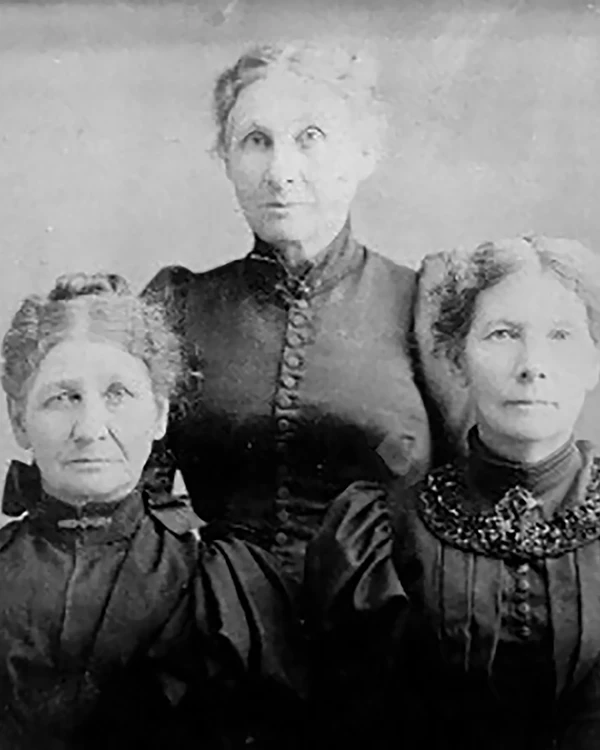Last updated: March 8, 2023
Person
Matilda and Elizabeth Sager

Image/Public Domain
Elizabeth and Matilda Sager were four and six years old, respectively, when they began their fateful journey west across the plains as part of The Independent Colony—a group of three hundred people and seventy-two wagons under the leadership of Capt. William Shaw. The sisters were accompanied by their parents Naomi and Henry Sager, as well as five other siblings. Their sister Catherine broke her leg just before they reached Fort Laramie; lacking access to a doctor, Henry had to set it himself. The Sagers encountered a German doctor by the name of Dagon at Fort Laramie. Wanting to keep an eye on Catherine’s injury, the doctor stayed with their party.
During the descent into present-day Wyoming’s Green River Valley, Henry fell with fever and died soon afterward. The good doctor offered to drive the Sager family’s wagon the rest of the way to the Willamette Valley. Naomi, already weak from giving birth on the journey, contracted a severe fever; knowing she would not survive, she asked that her children be put in the care of Marcus Whitman, a well-known missionary who had space enough to house the children. Perhaps Naomi also knew that Narcissa, Marcus’ wife, had recently lost her only daughter and had already taken in a number of emigrant children. Naomi Sager died near what is now Twin Falls, Idaho.
When they arrived at the Umatilla River, they camped for one or two days while Captain Shaw went to the Whitman Mission to see if they would take the children for the winter. Shaw’s plan was to pick them up in the spring of 1845 and settle them in the Willamette Valley. The Sagers reached the Whitman Mission in October. Elizabeth later described Narcissa Whitman as a “matronly woman ...who was rather reserved, and her hair was a coppery gold. She was rather plump, weighing about 150 pounds or more.” While Dr. Whitman was genial and kindly, Narcissa was the disciplinarian of the pair. The Sager orphans lived there for more than three years.
In 1847, tensions between the Whitmans and the Cayuse—Indigenous residents of the area—boiled over. Motivated by general trends, such as disease outbreaks and encroaching settlers, as well as more specific grievances, like the Whitmans’ refusal to pay for their land and the murder of a chief’s son, the Cayuse attacked the mission; they killed fourteen people, including Marcus, Narcissa, and the two Sager boys. The Cayuse took fifty-four women and children for ransom, among them Matilda, Elizabeth, Catherine, and Louise Sager—the latter of whom died of measles during their month-long captivity. During that time, Elizabeth witnessed the violent deaths of several fellow captives.
Elizabeth was one of forty-two children living at or near the mission at the time of the incident. Eventually, Peter Skene Ogden of the Hudson’s Bay Company came to the captives’ rescue; he traded sixty-two blankets, sixty-three cotton shirts, twelve rifles, six hundred loads of ammunition, seven pounds of tobacco, and twelve flints for the return of the surviving captives, who were brought to Fort Vancouver and released. After their liberation from the Whitman Mission, the Sager children went their separate ways. Elizabeth lived and worked for brief periods in the homes of other families. She married William Helm in the summer after her eighteenth birthday, and the pair spent more than forty years working on farms and ranches around Lebanon, Prineville, and The Dalles. They had nine children together. Elizabeth moved to Portland after her husband’s death in 1915, where she continued to live until her own passing on 19 July 1925.
Matilda ended up in the home of William Geiger, a newly-married doctor. While there, she spent two terms at a school in Forest Grove and worked for her board when the school moved to a new location in nearby Hillsboro. Fifteen-year-old Matilda married Lewis Hazlitt on 5 June 1855. The couple moved to Henley (now Cottonwood) California, Hazlitt died in the spring of 1863—leaving Matilda widowed with five children at the age of twenty-four. Matilda married her second husband in 1865. He was a partner of her first husband and had helped Matilda care for her homestead in the years since his death. They had three daughters together. In 1882 they sold the farm in Henley and moved to Farmington, Washington, where they invested in a hotel, a furniture store, a livery stable, and an undertaking business. Within a year, however, Matthew’s death left Matilda widowed for the second time. She married her third husband, David Delaney, in 1889.
Around that time, a proposal surfaced to remove the victims’ remains from the Whitman Mission to Whitman College. Matilda, writing to the Walla Walla Journal, called this an “act of vandalism.” She was satisfied, however, in 1897 when the fiftieth anniversary ceremonies memorialized the remains at the site of the old mission—where she believed they belonged. Matilda lived out her years in the care of her children, spending the last days of her life at the home of her youngest daughter in Reseda, California. She died there on 13 April 1928, the last of the seven Sagers.
(Special thanks to UNM PhD candidate Angela Reiniche for compiling this information)
